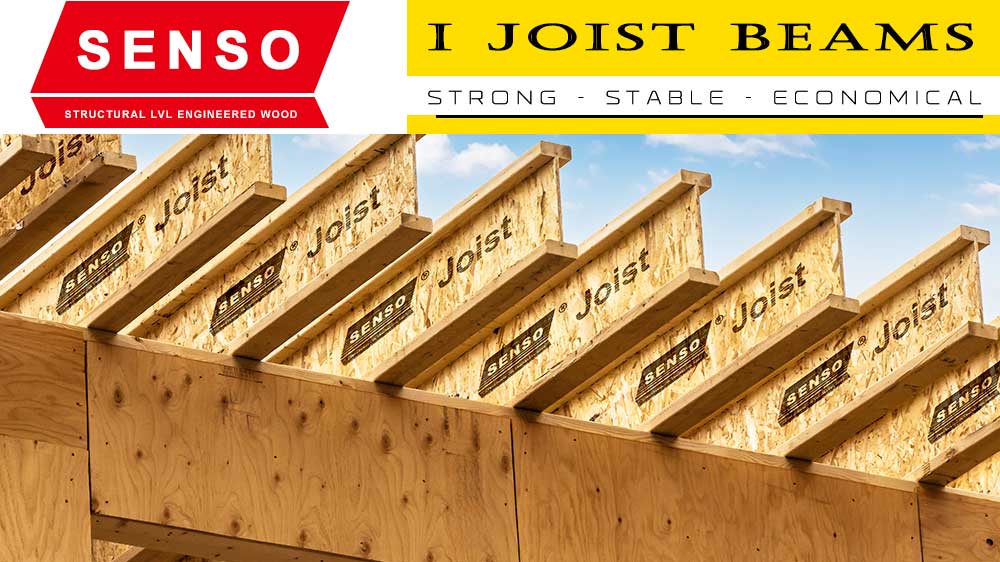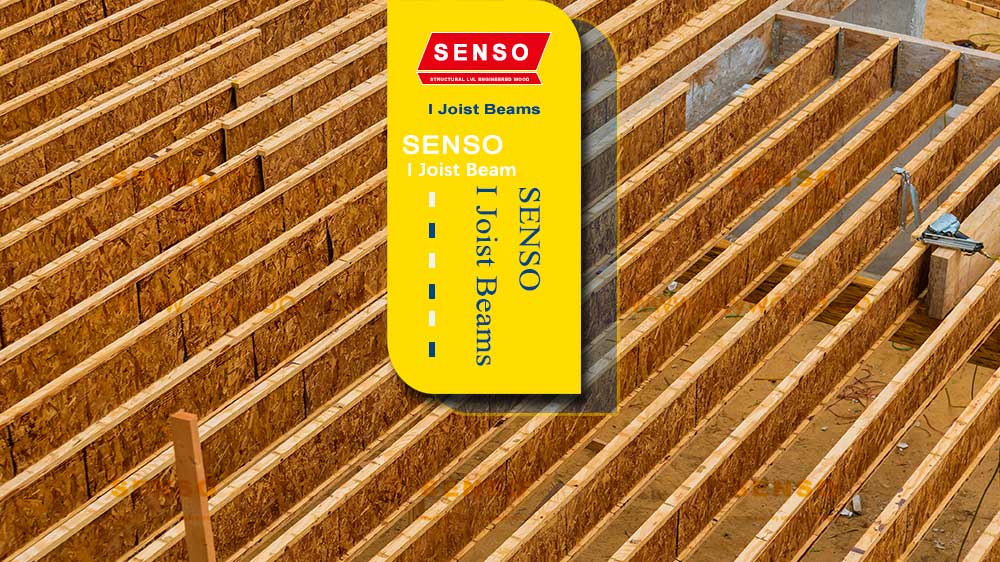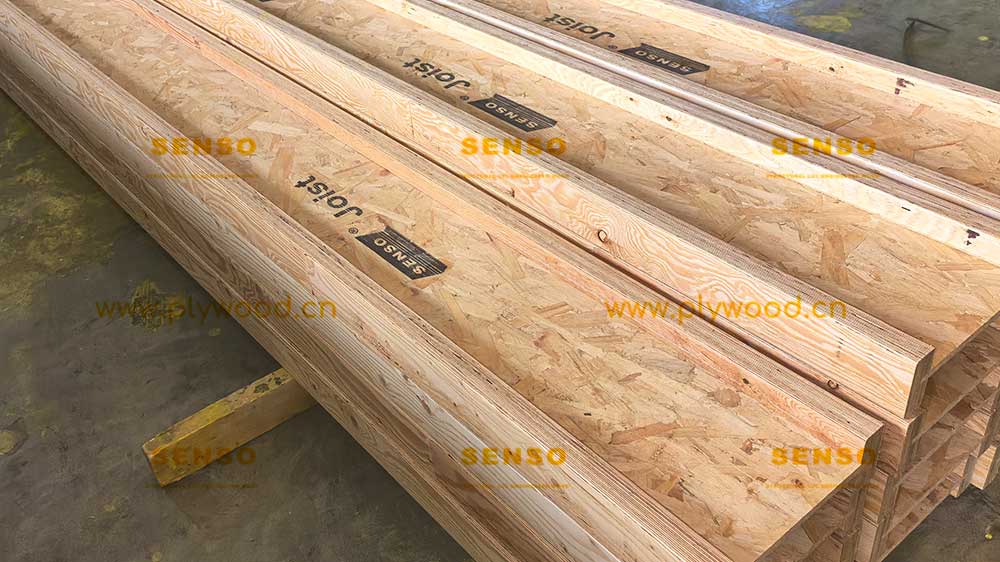What is a Wood I Joist?
In the realm of modern construction, the wood I joist stands out as a revolutionary component. At its core, a wood I joist is an engineered wood product that resembles the letter ‘I’ in shape. This innovative design significantly enhances the joist’s strength and durability. It makes the joist a preferable choice for floor and roof support in both residential and commercial buildings. The top and bottom parts, known as flanges, are typically made of solid wood or laminated veneer lumber. The web, which connects these flanges, is usually made of plywood or oriented strand board (OSB). This combination not only provides superior load-bearing capacity but also offers flexibility in design and application.
Advantages of Wood I Joist in Construction
Enhanced Strength and Durability:
Wood I joists are designed to withstand heavy loads, reducing the likelihood of warping, twisting, or shrinking. This resilience ensures a long-lasting and stable structure.
Wood I Joist Versatility in Design:
Their adaptable nature allows architects and builders to explore innovative design possibilities, especially in terms of larger spaces and longer spans without support columns.
Wood I Joist Eco-friendly and Cost-effective:
Made from engineered wood, these joists are a sustainable choice, utilizing smaller trees and reducing waste. Additionally, their dimensional stability translates to less material usage and waste during construction, making them a cost-effective solution.
Ease of Installation and Customization:
Lightweight and easy to handle, wood I joists can be quickly installed. They also allow for easy customization and integration of mechanical systems like plumbing and electrical wiring, thanks to the space provided by their design.
Revolutionizing Floor Systems: I Beam Floor Joists
The application of wood I joists in floor systems has brought about a significant shift in how buildings are structured. With the ability to cover large spans without the need for intermediate support, these joists have made open-concept designs more feasible and attractive. The uniformity in their manufacture ensures a level and squeak-free floor, a much-desired attribute in quality construction.
Structural Integrity with I Beam Joists
The I beam configuration in these joists contributes immensely to the structural integrity of buildings. This shape, inherently strong and capable of bearing substantial loads, is pivotal in providing support to floors and roofs. By efficiently distributing weight and reducing the load on other structural elements, I beam joists play a crucial role in the overall stability of the construction.
Innovative Applications and Future Prospects
The wood I joist is not just limited to traditional building applications. Its versatility is being explored in various innovative construction projects, including modular homes and prefabricated structures. As the construction industry evolves, the potential for these joists in terms of design flexibility and environmental sustainability is immense. Their role in supporting green building practices, particularly in reducing carbon footprint, is increasingly being recognized.
Wood I joist represents a significant advancement in building technology. Combining strength, versatility, and sustainability, it offers a modern solution to age-old construction challenges. As the industry continues to innovate, the wood I joist is set to play a pivotal role in shaping the future of construction.
Tailoring to Modern Needs: Customizable I Joist Solutions
The adaptability of wood I joist extends to their ability to be customized for specific project requirements. This customization potential is a significant advantage, particularly in complex architectural designs where standard joist sizes might not suffice. Custom-cut holes for ductwork, plumbing, and electrical systems can be incorporated into these joists without compromising their structural integrity. This feature simplifies the installation of building services and enhances overall construction efficiency.
Economic Benefits: Cost-Effectiveness of I Beam Joists
While the initial cost of wood I joists may be higher than traditional lumber, their long-term economic benefits are undeniable. The reduction in labor costs is one of the key benefits of these joists. Faster installation, minimal waste, and lower maintenance needs all contribute to cost savings. Additionally, their dimensional stability results in fewer callbacks for builders. Issues like creaky floors and drywall cracks are significantly reduced. These factors contribute to a higher return on investment for builders and property owners alike.
Sustainable Construction with Engineered Wood Joist
Environmental sustainability is a critical aspect of modern construction, and wood I joists contribute positively in this regard. Sourced from renewable forests and made using smaller, younger trees, these joists are an eco-friendlier alternative to traditional lumber. The production process also allows for the utilization of wood remnants, reducing waste. Moreover, the energy efficiency of buildings is enhanced due to the joists’ ability to accommodate thicker insulation, thereby contributing to reduced energy costs and a smaller carbon footprint.
Enhancing Safety and Compliance: I Joists in Building Codes
Safety is paramount in construction, and wood I joists align well with this priority. Their consistent quality and performance make them a reliable option, meeting and often exceeding building code requirements. The predictability in their behavior under load conditions adds an extra layer of safety in structural design. As building codes evolve to address modern construction challenges, wood I joists are increasingly recognized for their compliance and superior performance.
Challenges and Solutions in I Joist Installation
Despite their many advantages, challenges can arise during the installation of wood I joist. One such challenge is ensuring proper handling and storage to prevent damage. However, this can be mitigated through appropriate training and adherence to manufacturer guidelines. Another potential issue is the accurate placement of holes for utilities, which requires careful planning and execution. Solutions such as pre-planned cutouts and the use of specialized software for design and layout can effectively address these challenges.
I Joists and Fire Safety: Mitigating Risks
Fire safety is a concern with any building material, and wood I joist are no exception. However, steps can be taken to mitigate risks. The use of fire-resistant coatings and integrating fire stops within floor systems are effective measures. Additionally, adhering to building codes regarding the placement of electrical and plumbing systems within the joist cavities can further enhance fire safety.
Exploring the Aesthetic Appeal of I Beam Joists
Beyond their structural capabilities, wood I joist also offer aesthetic benefits. Their ability to support larger, open spaces without visible support beams lends itself to contemporary architectural trends. The clean, unobtrusive appearance of these joists when used in exposed applications adds to the aesthetic value of a space, providing a blend of functionality and visual appeal.
Innovative Use Cases: Beyond Traditional Structures
The use of wood I joist is not limited to residential and commercial buildings. Their application in unique structures such as bridges, warehouses, and even temporary event structures demonstrates their versatility. In such applications, the joists’ strength and lightweight nature are particularly advantageous, allowing for innovative and efficient structural solutions.
Wood I joists represent a significant step forward in building technology. Wood I joists offer a combination of strength, flexibility, economic benefits, and environmental sustainability. These features make them well-suited to meet the demands of modern construction. As the industry continues to evolve, the role of wood I joist in innovative and efficient building designs is set to grow. They are becoming a key component in the future of construction.
Integrating Technology with I Beam Joist
The integration of technology in construction has seen a remarkable synergy with the use of wood I joist. Advanced software for structural analysis and design is being employed to optimize the use of I joists in various projects. This technology allows for precise calculations of load-bearing capacities. It ensures the safe and efficient use of these joists in complex structures. Additionally, the use of Building Information Modeling (BIM) systems improves coordination among different construction phases. This enhances overall project management and reduces the margin for error.
Wood I Joist Impact on Residential Construction
In the realm of residential construction, wood I joist have revolutionized how homes are built. They allow for more open and flexible floor plans, catering to the modern homeowner’s preference for spacious, unobstructed living areas. Their use in multi-story buildings is particularly beneficial, providing strong and silent floor systems. This has significantly improved the quality of living in such structures, where noise transmission can be a concern.
Commercial Applications: Maximizing Space and Efficiency
In commercial buildings, the advantages of wood I joist are amplified. They allow for large, open spaces that are essential in settings like offices, shopping centers, and educational institutions. The flexibility in design also enables architects to create more dynamic and visually appealing spaces. Additionally, the ease of incorporating HVAC and other systems within these joists makes them an ideal choice for complex commercial constructions.
Environmental Impact: A Sustainable Choice
The environmental impact of construction materials is a growing concern, and wood I joists stand out as a sustainable option. Their production involves less energy consumption compared to steel or concrete and has a lower carbon footprint. This aligns with the increasing emphasis on green building practices and sustainable development in the construction industry.
Looking Ahead: The Future of I Joists in Construction
As the construction industry continues to evolve, the potential for wood I joist in future developments is immense. Innovations in material science could lead to even stronger and more sustainable versions of these joists. Their application might extend beyond traditional construction, possibly playing a role in disaster-resistant building designs or in temporary structures requiring quick assembly and disassembly.
Wood I Joist Frequently Asked Questions (FAQs)
Q: What is the difference between a joist and an I-joist?
A: A traditional joist is a horizontal structural member used in framing. It spans an open space, often between beams that transfer loads to vertical members. An I-joist, on the other hand, is an engineered wood product. It has greater load-bearing capacities and is more resistant to warping and twisting.
Q: What is an advantage of an I-joist?
A: The main advantage of an I-joist is its strength and stability. It can span longer distances than traditional lumber, reducing the need for support columns and allowing for more flexible floor plans.
Q: Are I-joists stronger than timber?
A: Yes, I-joists are typically stronger than solid timber of the same size. This is due to their engineered design, which maximizes strength and minimizes material defects.
Q: What are the disadvantages of I-joist?
A: The main disadvantages of I-joists include higher initial costs compared to traditional lumber and the need for careful handling and installation to prevent damage.
Q: Are wood I joist better?
A: I-joists are better in terms of strength, stability, and versatility for certain applications, particularly where long spans and open floor plans are desired. However, the choice between I-joists and traditional lumber depends on the specific requirements of the project.
Wood I joists represent a transformative element in the construction industry. Balancing strength, flexibility, and sustainability, they offer an effective solution to modern building challenges. As we look to the future, the role of wood I joists in shaping innovative and efficient construction practices is undoubtedly significant. They are becoming a key component in the evolution of building technology.
Post time: 2 月-18-2025




